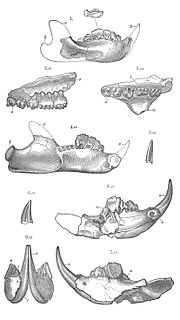 W
WAllodontidae is a family of extinct multituberculate mammal that lived in what is now North America during the Upper Jurassic period. They were relatively early mammals and are within the informal suborder of "Plagiaulacida". The family was named by Othniel Charles Marsh in 1889. Two genera are recognized: Ctenacodon and Psalodon.
 W
WAmphitheriidae is a family of Mesozoic mammals restricted to the Middle Jurassic of Britain, with indeterminate members also possibly known from the equivalently aged Itat Formation in Siberia and the Anoual Formation of Morocco. They were members of Cladotheria, more derived than members of Dryolestida, and forming a close relationship with Peramuridae. Amphitheriidae is the only family of the order Amphitheriida.
 W
WAmphitherium is an extinct genus of stem cladotherian mammal that lived during the Middle Jurassic of England. It was one of the first Mesozoic mammals ever described. A recent phylogenetic study found it to be the sister taxon of Palaeoxonodon. It is found in the Forest Marble Formation and the Taynton Limestone Formation.
 W
WBrancatherulum is an extinct genus of Late Jurassic mammal from the Tendaguru Formation of Tanzania. It is based on a single toothless dentary 21 mm in length. It is currently considered either a stem-zatherian or dryolestidan.
 W
WCtenacodon is a genus of extinct mammal that lived in what is now North America during the Upper Jurassic period. It is a member of the family Allodontidae within the order Multituberculata. Ctenacodon, also known as Allodon, was named by Othniel Charles Marsh in 1879. At least three species are currently recognized.
 W
WDryolestes is an extinct genus of Late Jurassic mammal from the Morrison Formation and the Alcobaça Formation of Portugal. The type species Dryolestes priscus is present in stratigraphic zones 2, 5, and 6.
 W
WDryolestidae was a widespread family of Mesozoic mammals. The clade is not based on a phylogenetic definition, but instead on the possession of unequal roots for the molars of the lower jaw. Additionally, the clade is distinguished by hypsodonty in lower molars, and uneven labio-lingual height for the alveolar borders of the dentary.
 W
WHenkelotherium is an extinct genus of mammal from the Late Jurassic (Kimmeridgian) Camadas de Guimarota, in Portugal. It differs from most other paurodontids in having more postcanine teeth.
 W
WHenosferidae is an extinct family of Australosphenida, native to Gondwana during the Middle Jurassic. Its defined as a clade including the most recent common ancestor of Henosferus and Asfaltomylos and all its descendants.
 W
WLaolestes is an extinct genus of dryolestid mammal. Remains are known from the Morrison Formation, in stratigraphic zones 5 and 6., the Late Jurassic of Portugal, and Early Cretaceous Wadhurst Clay of UK.
 W
WPaulchoffatia is a genus of extinct mammal of the Upper Jurassic - Lower Cretaceous. It was a relatively early member of the also extinct order Multituberculata, within the suborder "Plagiaulacida" and family Paulchoffatiidae. It lived in Europe during the "age of the dinosaurs."
 W
WPaurodon is an extinct genus of Late Jurassic mammal from the Morrison Formation of the Western United States.
 W
WPeramus is an extinct genus of cladotherian mammal. It lived in the Late Jurassic and Early Cretaceous of Europe and North Africa.
 W
WPhascolotherium is a genus of extinct eutriconodont mammal from the Middle Jurassic of the United Kingdom. Found in the Stonesfield Slate, it was one of the first Mesozoic mammals ever found and described, although like the other mammal jaws found at the same time, it was mistakenly thought at first to be a marsupial.
 W
WPseudotribos is an extinct genus of mammal that lived in Northern China during the Middle Jurassic some 165 million years ago, possibly more closely related to monotremes than to theria, although other studies indicate that these shuotheres are closer to therians than to monotremes. The only known specimen was found in the Daohugou Bed in Inner Mongolia.
 W
WShuotheriidae is a small family of Jurassic mammals whose remains are found in China, England and possibly Russia. They have been proposed to be close relatives of Australosphenida, the group that contains living monotremes, together forming the clade Yinotheria. However, some studies suggest shuotheres are closer to therians than to monotremes. The Shuotheriidae have been proposed as the sister group of the Gondwanian clade Henosferida and the Monotremata, which are the monotremes.